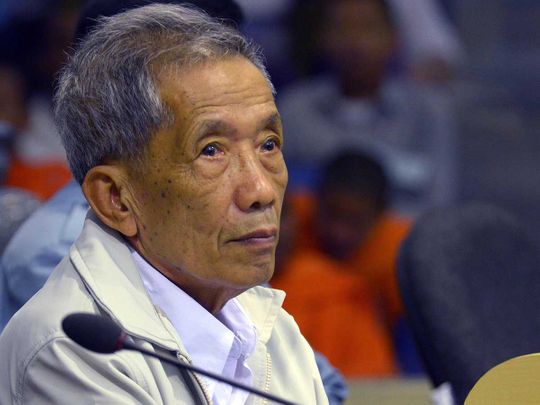
Phnom Penh: Kaing Guek Eav, the former schoolteacher known as Duch who became the most notorious killer during the Khmer Rouge reign of terror in Cambodia in the 1970s, died on Wednesday at Khmer Soviet Friendship Hospital in Phnom Penh, Cambodia. He was 77.
He was admitted to the hospital Tuesday, and his death was announced by Neth Pheaktra, spokesman for the Khmer Rouge Tribunal in Phnom Penh.
Duch was sentenced to life imprisonment in 2010 for atrocities he had committed as a commandant of the Tuol Sleng prison. At least 14,000 people died after being held there, most of them sent to a killing field after being tortured and forced to confess to often imaginary crimes. Only a handful survived.
Duch (pronounced doik) and Tuol Sleng prison became a symbol of the brutality of the Khmer Rouge as it devoured itself in paranoia and purges. Under the regime, from 1975 to 1979, at least 1.7 million people died from execution, torture, starvation, untreated disease or overwork.
A joint Cambodian-United Nations tribunal found Duch guilty of crimes against humanity and war crimes as well as homicide and torture.
A schoolteacher before the Khmer Rouge came to power, he took his revolutionary name from a children’s book about an obedient schoolboy named Duch. “I wanted to be a well-disciplined boy who respected the teachers and did good deeds,” he told the court.
That obedience made him an effective operative for the top Khmer Rouge leadership. His chief defence was that he, too, had feared for his life if he did not carry out orders.
Strong personality
But the vigour, creativity and cruelty with which he ran his torture house belied that defence. And his brashness and arrogance during the trial were anything but that of a young innocent.
The force of his personality dominated the courtroom, and his self-confidence sometimes hardened into condescension as he corrected a lawyer or witness about details of the case against him.
At one point, a judge reminded him that laughter was not an appropriate response to a question.
A panel of court-appointed psychiatrists said that Duch was “meticulous, conscientious, control-oriented, attentive to detail and seeks recognition from his superiors,” and that he exhibited “a strong presence of obsessive traits.”
One question hovered above the trial: the source of the “evil” - as he himself described it - that could have compelled him to scribble on a list of 17 children, “Kill them all.”
“How do human beings become part of a project of mass murder,” asked Alex Hinton, the author of “Man or Monster,” a book about Duch. “It’s too easy to dismiss people as sociopaths or psychos. Instead you really have to grapple with their humanity.”
Early life
Duch was born Kaing Guek Eav on Nov. 17, 1942, to a family of Chinese immigrants in Kampong Thom province, in central Cambodia. He was a star pupil in school, rising through elite institutions to gain a baccalaureate in mathematics at the prestigious LycEe Sisowath in Phnom Penh, the capital.
He joined the Khmer Rouge, a radical communist movement, in 1967 when it was still a jungle insurgency. He honed his interrogation skills at two prisons he ran in territory that the group controlled.
Duch said he had picked up beating techniques from Cambodian and French police manuals and worked out his own system through trial and error. In passing on his techniques, he said, he often had to instruct young recruits not to get carried away during torture and kill the prisoner. When this happened in Tuol Sleng, the interrogator himself could be sentenced to death.
While running the prison, he was also appointed to head the Santebal, the “special branch,” which was in charge of internal security and prisons.
When a Vietnamese invasion drove the Khmer Rouge from Phnom Penh in January 1979, Duch oversaw the execution of the remaining prisoners. But he did not destroy the records of interrogations, meticulously kept accounts that could run to as many as 200 pages. They amounted, in the end, to his life’s work.
Conversion to Christianity
After fleeing Phnom Penh, Duch appeared to undergo a dramatic life change, converting to Christianity while living in refugee communities along the border with Thailand. As a religion of forgiveness, Christianity, if his embrace of it was genuine, may have appealed to a sense of guilt. He sometimes carried a Bible into the courtroom during his trial.
Duch was discovered in 1999 by photographer Nic Dunlop, who later wrote a book about him, “The Lost Executioner.”
Before being arrested shortly afterward, he told Dunlop and journalist Nate Thayer that he had decided to confess to prove that the prison, known to the regime as S-21, had really existed, rebutting a claim by the Khmer Rouge leader Pol Pot that accounts of it were propaganda fiction.
During his trial, however, Duch seemed to doubt the validity of his work, telling the courtroom that while running the prison he did not believe most confessions that his torturers had extracted and that he then annotated and sent to his superiors.
“I never believed that the confessions I received told the truth,” he said. “At most, they were about 40% true.”
And he said he believed that only 20% of the people whose names had been extracted through torture were genuine opponents of the regime. Those people were in turn pursued, arrested and tortured until they, too, produced the names of imagined accomplices.
“The work expanded,” Duch said. “People were arrested illegally, right or wrong. I considered it evil eating evil.”
Two other defendants died during the trial. Pol Pot died in 1998.
Duch was said to have had four children, but information about his survivors was not available. His wife was reported to have been killed in a robbery.








